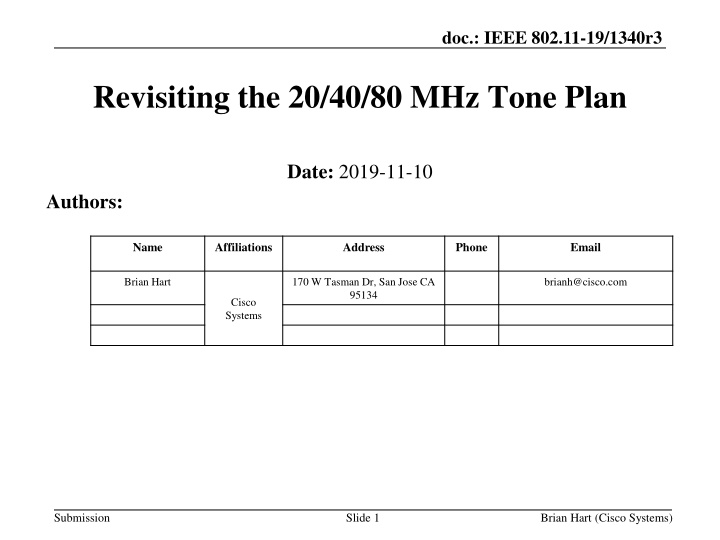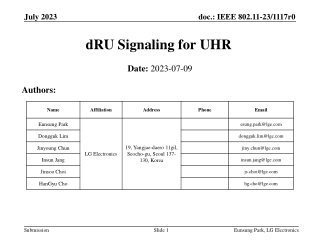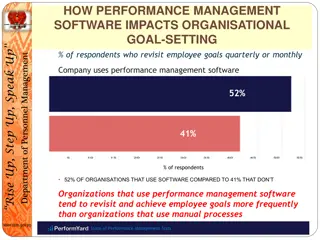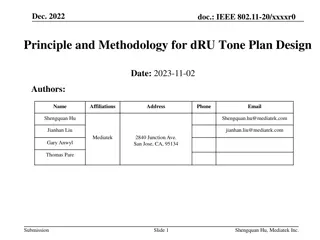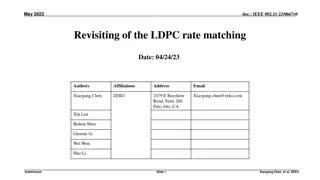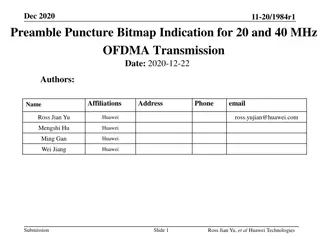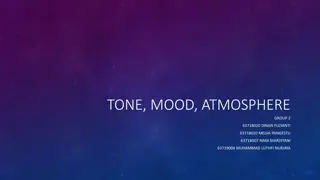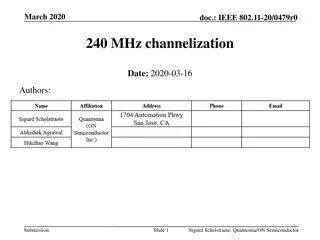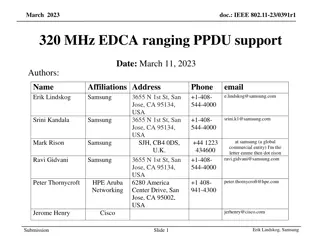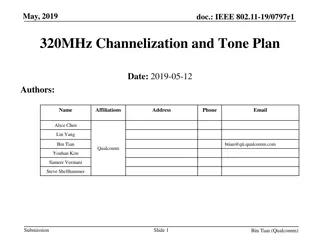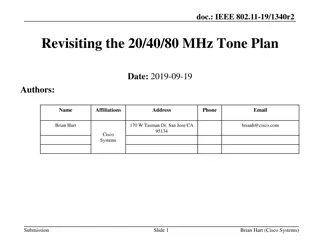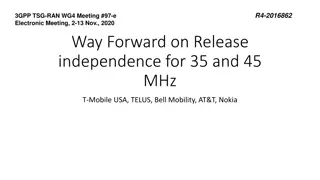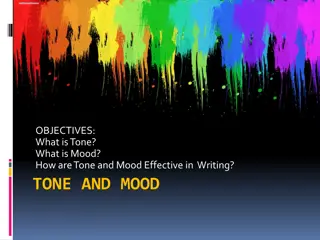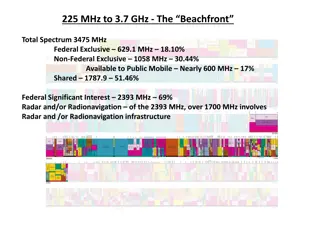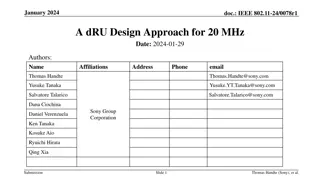Revisiting the 20/40/80 MHz Tone Plan
This document delves into the revisitation of the 20/40/80 MHz tone plan in IEEE 802.11 standards, addressing issues such as inefficient spectrum usage for different bandwidth devices and the impact on throughput and efficiency. It explores the need for optimizing tone plans for various scenarios, considering factors like power savings, edge tones, and support for different bandwidths.
Download Presentation

Please find below an Image/Link to download the presentation.
The content on the website is provided AS IS for your information and personal use only. It may not be sold, licensed, or shared on other websites without obtaining consent from the author.If you encounter any issues during the download, it is possible that the publisher has removed the file from their server.
You are allowed to download the files provided on this website for personal or commercial use, subject to the condition that they are used lawfully. All files are the property of their respective owners.
The content on the website is provided AS IS for your information and personal use only. It may not be sold, licensed, or shared on other websites without obtaining consent from the author.
E N D
Presentation Transcript
doc.: IEEE 802.11-19/1340r3 Revisiting the 20/40/80 MHz Tone Plan Date: 2019-11-10 Authors: Name Affiliations Address Phone Email Brian Hart 170 W Tasman Dr, San Jose CA 95134 brianh@cisco.com Cisco Systems Submission Slide 1 Brian Hart (Cisco Systems)
doc.: IEEE 802.11-19/1340r3 Situation A 11ax developed a tone plan optimized for throughput and the presence of the central RU26, with one distinct tone plan per bandwidth At the development time, certain ultimate 11ax features were unknown, unclear or TBD: 20 MHz-only STAs STAs reducing their BW for power savings Preamble-puncturing This tone plan is implemented in all 11ax devices 802.11 has performed do-overs in the past e.g. 11ac simplified the pilot tone design wrt 11n Submission Slide 2 Brian Hart (Cisco Systems)
doc.: IEEE 802.11-19/1340r3 Problem A Certain RUs are close to a band edge or near a DC tone, and these RUs are unavailable to: 20 MHz-only STAs STAs reducing their BW for power savings Preamble-puncturing (edge RUs only) i.e. very difficult for a scheduler to allocate For example, for each row of the figure, when these RUs are unallocated, there is an efficiency loss of [19 24 35 2.5 2.5 0]% Conversely, any new plan without these disadvantages will be a new tone plan, so 11be devices must implement both 11ax and 11be tone plans Submission Slide 3 Brian Hart (Cisco Systems)
doc.: IEEE 802.11-19/1340r3 Situation B OFDMA provides maximum efficiency when UL/DL OFDMA always spans the BSS s operating bandwidth. A normal STA operating with 80 MHz bandwidth can participate in the P80 of the TX/RX of 80/160/80+80 MHz OFDMA PPDUs A 20 MHz operating STA can optionally participate in the P20 of the TX/RX of a 40/80/160 MHz transmission Further 11ax defined the optional Subchannel Selective Transmission (SST) feature A 20 MHz-only STA or 20 MHz operating STA that supports SST can occupy any 20 MHz and can participate in the TX/RX of OFDMA PPDUs of any bandwidth A normal STA that supports SST can occupy any 80 MHz within 160/80+80 MHz Submission Slide 4 Brian Hart (Cisco Systems)
doc.: IEEE 802.11-19/1340r3 Worst case scenario that wastes minimal spectrum: 20M STAs in 20M PPDU, 40M STAs in 40M PPDU, 80M STAs in 80M Problem B STAs operating in lower bandwidths may be incapable of participating in wider bandwidth PPDUs, increasing overheads Because tone plan makes it much harder! And no solution exists for 40 MHz STAs! Even if capable, lack of support of SST causes a pile-up on P20 meaning S20/S40/S80 are under-utilized. PPDU Best case scenario: 40MHz STAs don t play nice Pile-up on Without SST, a huge amount of spectrum is under-utilized P20 PPDU 40MHz STA One One PPDU 20MHz STA PPDU One One PPDU PPDU 80MHz STA One PPDU One 160MHz STA PPDU One 320MHz STA? Submission Slide 5 Brian Hart (Cisco Systems)
doc.: IEEE 802.11-19/1340r3 Overarching Goal Will be vital for 160 and 320MHz Whatever a STA s capability 20 MHz only, 160 MHz Whatever a STA s power saving mode 20 / 40 / 80 /160 MHz Whatever subchannel the STA is parked on (P20 or another via SST or similar) P20 / S20 / 20 MHz in S40 / 20 MHz in S80 / 20 MHz in S160 Whatever is the EHTMU or EHTTB transmission bandwidth determined by the AP 20 / 40/ 80 / 160 / 320 MHz Whatever subchannels need to be punctured 20 / 40 / 60 / 80 / 100 / 120 the 802.11be PHY must define mandatory modes that enable the STA to participate in the transmission. Submission Slide 6 Brian Hart (Cisco Systems)
doc.: IEEE 802.11-19/1340r3 Helpful Technology: A Better Tone Plan Design Principles Seek a 20MHz-aligned tone plan with a much reuse and symmetry For different bandwidths With respect to 11ax Design a tone plan for a 20 MHz tile and replicate it to 40 and 80 MHz Works equally well for 80+80, 160, 160+160, 320 MHz and so forth To support TX/RX with 20/40/80 MHz BWs centered on any 20/40/80 MHz channel, The tone plan includes DC tones every n*10 MHz, The tone plan generally avoids RUs that near a 20 MHz boundary To avoid inefficiency, a new RU, RU18, is defined to occupy the otherwise-unused subcarriers between adjacent 20 MHz tiles Not used at the band-edge Still has room for 5 DC subcarriers for 40 and 80 MHz STAs The RU size is selected to maximize commonality with existing RUs This is possible for the larger RUs but not all of the smaller RUs Submission Slide 7 Brian Hart (Cisco Systems)
Tile = 230 data+null tones; also 3 DC tones Null tones doc.: IEEE 802.11-19/1340r3 18U + 3 DC tones / 12 Guard tones More / 12 Guard 18L + 2 DC tones / 11 Guard tones More / 11 Guard Helpful Technology 28 28 28 28 28 28 28 28 56 56 56 56 3 DC tones (for 20MHz STAs) 114 114 The 20 MHz tile (top right) is colored cyan The extended 20 MHz tile (right) merges the left and/or right guard tones with an RU and is colored green The guard and DC tones are white; the null tones are black RU18 is colored yellow. RU18 and 5DC tones replace the guard tones between two 20 MHz tiles Extreme consistency across 20 MHz tiles and PPDU bandwidths 230L 230U 484{L,U} 484{L,U} continued 996{LL,LM,UM,UU} 996{LL,LM,UM,UU} continued Tile (230) Tile (230) Tile (230) Tile (230) 18U 18U 18L 18L 12 Guard 11 Guard 18U 18L 3 5 3 5 3 5 3 484L 484U 484L 484U 996LL 996LM 996UM 996UU 80 MHz Tile (230) Tile (230) Tile (230) Tile (230) 12 Guard 11 Guard 12 Guard 11 Guard 18U 18U 18L 18L 3 5 3 3 5 3 484L 484U 484L 484U 40 MHz 40 MHz Tile (230) Tile (230) Tile (230) Tile (230) 12 Guard 11 Guard 12 Guard 11 Guard 12 Guard 11 Guard 12 Guard 11 Guard 3 3 3 3 Submission Slide 8 Brian Hart (Cisco Systems) 20 MHz 20 MHz 20 MHz 20 MHz
doc.: IEEE 802.11-19/1340r3 Helpful Technology: RU Details RU / nDataTones nPilotTones Reuses existing blocks? Efficiency wrt 80M 11ax STAs in 80M BSS Efficiency wrt 20M 11ax STAs in 80M BSS nUsedTones RU18 16 2 N N/A N/A RU28 26 (or 24) 2 (or 4) N (or Y) 99.1% 122.2% RU56 52 4 Y (11n/ac) 99.1% 131% RU114 108 6 Y (11n/ac) 97.4% 149% RU230 222 8 N 97.5% 100% RU484 468 16 Y 99.2% 101.7% RU996 980 16 Y 100% 100% This is remarkably beautiful The largest RUs are unchanged from 11ax For the corner case of all STAs operating at 80 MHz, the efficiency of the tone plan is very similar to 11ax For a poor case of all 20MHz-only STAs with SST, the tone plan is never worse and up to 49% more efficient than 11ax For the worst case of all 20 MHz-operating STAs, easily augmented with SST in 11be due to the more favorable tone plan, the tone plan is approx. 300% more efficient than 11ax Submission Slide 9 Brian Hart (Cisco Systems)
doc.: IEEE 802.11-19/1340r3 Conclusion We identify limitations with 11ax OFDMA that will only get worse with 320 MHz We identify that the 11ax tone plan for 20/40/80 MHz is part of the problem We propose new, helpful technology: an alternative tone plan that is very well matched to: 20MHz-only STAs + STAs that reduce their bandwidth for power saving reasons + Preamble puncturing + SST This tone plan is much simpler than the 11ax tone plan, due to its very high degree of consistency and symmetry But, the overarching goal is to ensure that any STA can participate in any OFDMA transmission under all circumstances Submission Slide 10 Brian Hart (Cisco Systems)
doc.: IEEE 802.11-19/1340r3 Backup Submission Slide 11 Brian Hart (Cisco Systems)
doc.: IEEE 802.11-19/1340r3 Strawpoll 1 Do you support that: Whatever a STA s capability Whatever a STA s power saving mode Whatever subchannel the STA is parked on (P20 or another via SST or similar) Whatever is the EHTMU or EHTTB transmission bandwidth determined by the AP Whatever subchannels need to be punctured the 802.11be PHY must define mandatory modes of operation that enable the STA to participate in the transmission? Y / N / A Submission Slide 12 Brian Hart (Cisco Systems)
doc.: IEEE 802.11-19/1340r3 Strawpoll 2 Do you support that the 11be tone plan should be designed to improve support, with respect to the 11ax tone plan, for 20 MHz-only STAs, preamble puncturing and STAs that reduce their operating bandwidth below the BSS operating bandwidth? Y / N / A Submission Slide 13 Brian Hart (Cisco Systems)
doc.: IEEE 802.11-19/1340r3 Tile (230) Tile (230) Tile (230) Tile (230) Just the Figures 18U 18U 18L 18L 12 Guard 11 Guard 18U 18L 3 5 3 5 3 5 3 484L 484U 484L 484U Tile = 230 data+null tones; also 3 DC tones Null tones 996LL 996LM 996UM 996UU 80 MHz 18U + 3 DC tones / 12 Guard tones More / 12 Guard 18L + 2 DC tones / 11 Guard tones 28 28 28 28 28 28 28 28 Tile (230) Tile (230) Tile (230) Tile (230) 12 Guard 11 Guard 12 Guard 11 Guard 18U 18U 18L 18L 56 56 56 56 3 DC tones (for 20MHz STAs) 3 5 3 3 5 3 484L 484U 484L 484U 114 114 40 MHz 40 MHz 230L 230U Tile (230) Tile (230) Tile (230) Tile (230) 12 Guard 11 Guard 12 Guard 11 Guard 12 Guard 11 Guard 12 Guard 11 Guard More / 11 Guard 484{L,U} 484{L,U} continued 3 3 3 3 996{LL,LM,UM,UU} 996{LL,LM,UM,UU} continued 20 MHz 20 MHz 20 MHz 20 MHz Tile (230) Tile (230) Tile (230) Tile (230) Tile (230) Tile (230) Tile (230) Tile (230) 18U 18U 18U 18U 18L 18L 18L 18L 18U 18U 18L 18L 3 5 3 5 3 5 3 5 3 5 3 5 3 5 3 12 Guard 11 Guard 18U 18L 484L 484U 484L 484U 484L 484U 484L 484U 996LL 996LM 996UM 996UU 996LL 996LM 996UM 996UU 2x996LLL 2x996LLM 2x996LUM 2x996LUU 2x996ULL 2x996ULM 2x996UUM 2x996UUU 160 MHz Submission Slide 14 Brian Hart (Cisco Systems)
